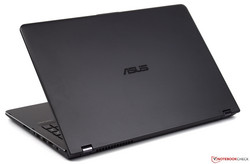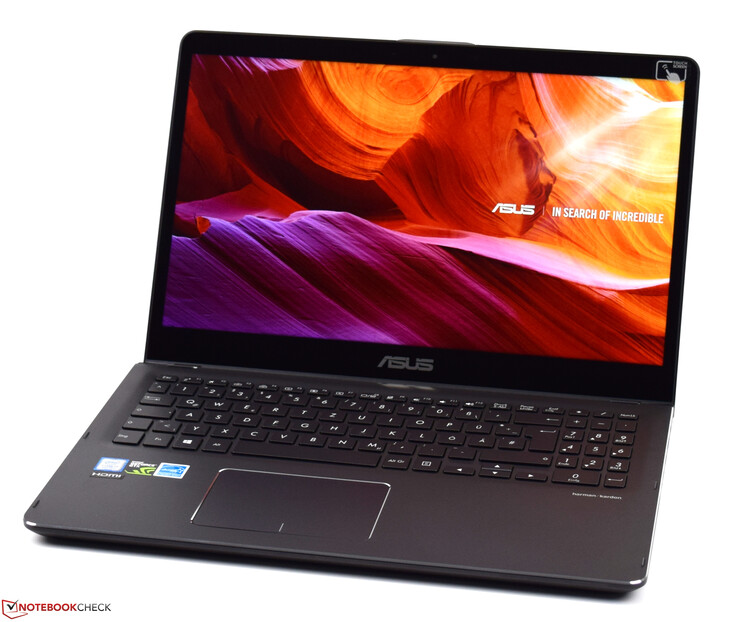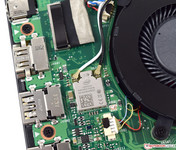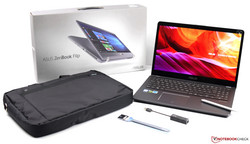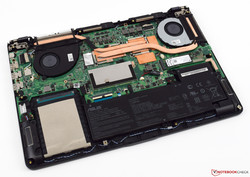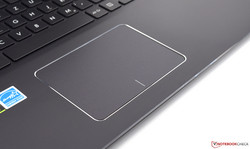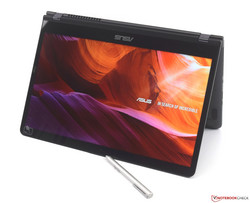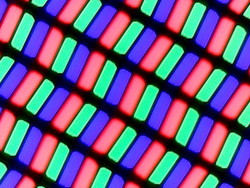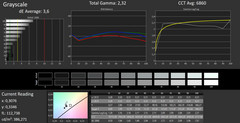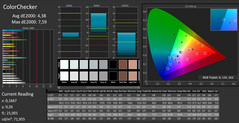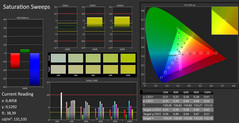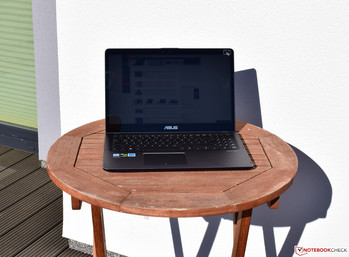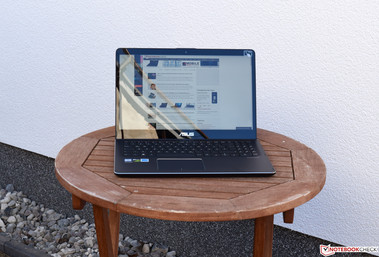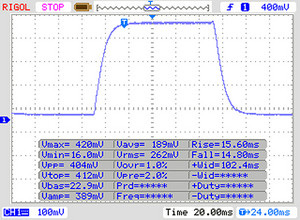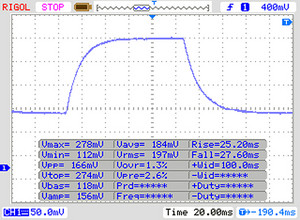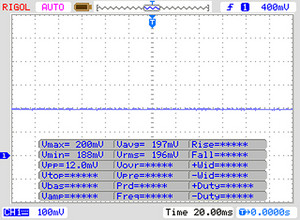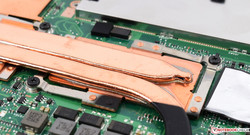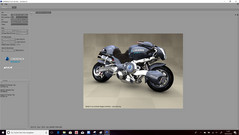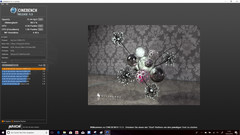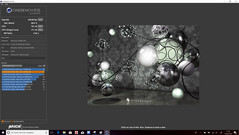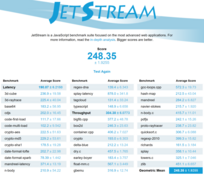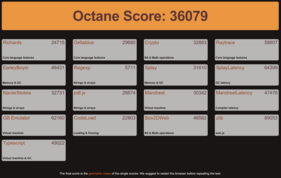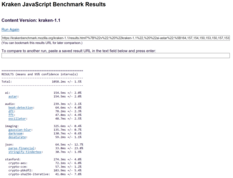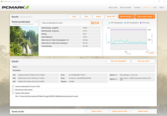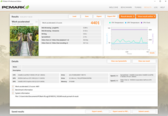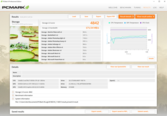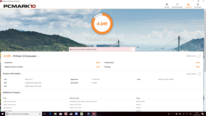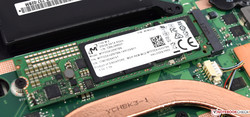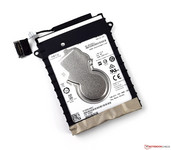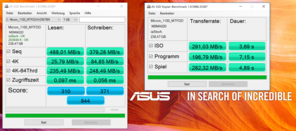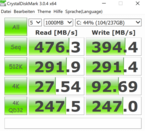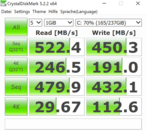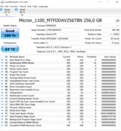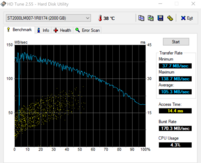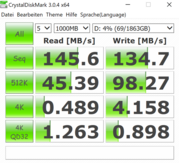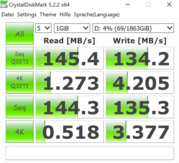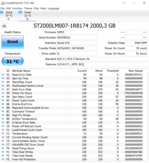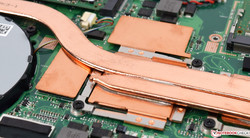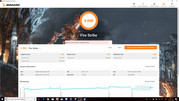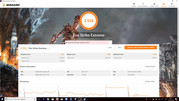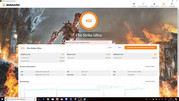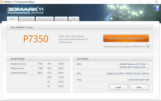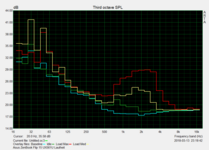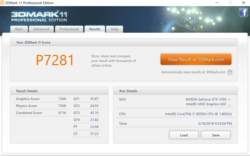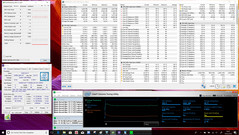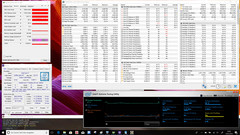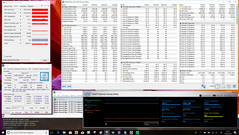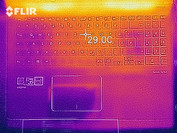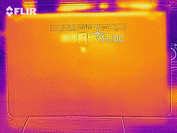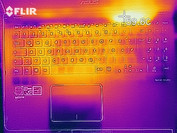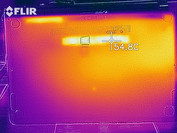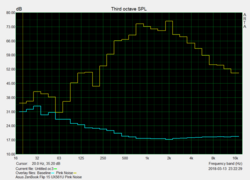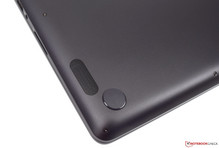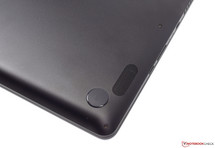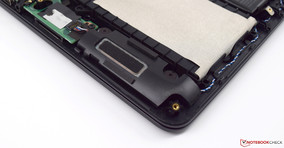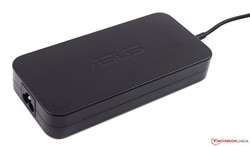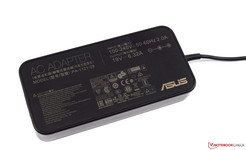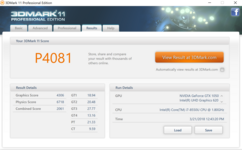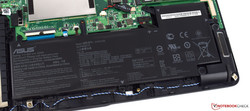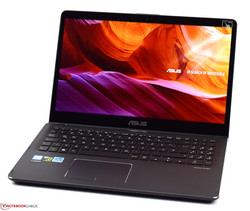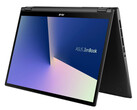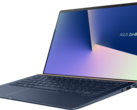Asus ZenBook Flip 15 (i7-8550U, GTX 1050, 4K, SSD, HDD) Convertible Review

Convertibles are still in high demand for the end user. Especially Intel's new generation of processors boosts the performance noticeably by uniting four physical processing units into one ULV SoC. Users purchasing the new Asus ZenBook Flip 15 benefit from this performance boost as well and will be able to work at high speeds with the Intel Core i7-8550U. The remaining hardware is nothing to sneeze at either. The thin convertible offers sufficient storage space with its configuration consisting of an SSD (256 GB) and an HDD (2 TB). This storage space can be put to good use, since the convertible's good midrange GPU (Nvidia GeForce GTX 1050) enables the user to play even recent games. Furthermore, our test device is equipped with a 4K touchscreen. This much can be said right away: We really liked that screen. All things considered, the Asus ZenBook Flip 15 is a very good all-rounder. The purchase price of 1799 Euros is not to be neglected, though. Still, the laptop is of a high quality and has a robust build. Several useful additions complete the package. Sadly, very few alternative configurations are available. A model equipped with an FHD panel, as well as a model with a different storage solution are available online.
The stylish ZenBook Flip 15 has to compete with other current convertibles which can be found in the list below.
| Acer Spin 5 | HP Envy x360 15 | Lenovo Yoga 720 | HP Spectre x360 13t | Lenovo ThinkPad X1 Yoga | |
| CPU | Intel Core i7-8550U | AMD Ryzen 5 2500U | Intel Core i7-7700HQ | Intel Core i7-8550U | Intel Core i7-7600U |
| GPU | NVIDIA GeForce GTX 1050 | AMD Radeon RX Vega 8 | NVIDIA GeForce GTX 1050 | Intel UHD Graphics 620 | Intel HD Graphics 620 |
| Display | 15.6 inch 1920 x 1080 (IPS) | 15.6 inch 1920 x 1080 (IPS) | 15.6 inch 1920 x 1080 (IPS) | 13.3 inch 1920 x 1080 (IPS) | 14 inch 2560 x 1440 (IPS) |
| RAM | 8 GB DDR4 | 8 GB DDR4 | 8 GB DDR4 | 16 GB DDR3 | 16 GB DDR3 |
| Storage | 256 GB SSD + 1 TB HDD | 256 GB SSD | 256 GB SSD | 1024 GB SSD | 1024 GB SSD |
| Rating | 82% | 80% | 82% | 88% | 88% |
Case - Asus ZenBook Meets Aluminum
The ZenBook's case is made almost entirely of aluminum. In terms of color, the case is mostly gray with chamfered edges providing subtle contrasts. The robust base plate was very convincing and could only be twisted with effort, and even then only minimally. The same is true for the display lid, which also had a good result in the pressure test, since we were unable to produce any ripples on our test device. The base unit did well in the pressure test, too. The only spot that yielded slightly was in the middle of the keyboard, but this is not too much of a problem. The two small but robust 360-degree hinges are able to transform the device into a tablet in an instant. In laptop mode, the two hinges offer ample support and they reduce any bouncing with vibrations to a minimum. The case cannot be opened with one hand because the hinges are a bit too stiff for that. Overall, the Asus ZenBook Flip 15 gives a high-quality impression, not only visually, but also tangibly. However, fingerprints tend to be visible very clearly on the convertible's surfaces. They can be easily removed with a soft cloth, though.
Size Comparison
The Asus ZenBook Flip 15 has a footprint of 364 x 246 millimeters, which is not overly much. The Lenovo ThinkPad X1 as well as the HP Spectre x360 are built in a way that makes them require less space, though. At 2.1 kilograms, the ZenBook's weight is still acceptable. Only the Acer Spin 5 is even heavier at 2.3 kilograms. The 120-watt power supply weighs an additional 562 grams, which makes it slightly heavier than the power supplies of the comparison devices which do not have a dedicated graphics card.
Connectivity - Asus Ultrabook Offers USB 3.1 Type-C Gen 2
The connectivity of the Asus ZenBook Flip 15 is modern and offers everything a current convertible should have. In addition to the two USB 3.0 ports, a fast USB 3.1 Type-C Gen 2 port can be found on the opposite side of the device. There is also an HDMI output, enabling the user to easily connect an external monitor. The ports are well-positioned on the sides of the device and the power cable's angled connector does a good job at directing it to the back.
SD Card Reader
The memory card reader on the right side is able to process all common SD cards. Inserted storage media protrude clearly from the slot, though, which poses a risk of damage. We tested the card reader's performance with our reference card Toshiba Exceria Pro SDXC 64 GB UHS-II. At 35.5 MB/s, the Asus ZenBook Flip 15 had the second-lowest sequential read speed. Sadly, the ZenBook placed in one of the lower ranks for copying images as well because the memory card reader can only perform at USB 2.0 speed. These results put the Asus ZenBook Flip 15 clearly below average in the comparison field.
| SD Card Reader | |
| average JPG Copy Test (av. of 3 runs) | |
| HP Spectre x360 13-ae048ng (Toshiba Exceria Pro M501 microSDXC 64GB) | |
| Lenovo ThinkPad X1 Yoga 2017 20JES03T00 (Toshiba Exceria Pro M401) | |
| Average of class Convertible (28.1 - 209, n=23, last 2 years) | |
| HP Envy x360 15-bq102ng (Toshiba Exceria Pro SDXC 64 GB UHS-II) | |
| Asus ZenBook Flip 15 UX561UD (Toshiba Exceria Pro SDXC 64 GB UHS-II) | |
| Acer Spin 5 SP515-51GN-80A3 (Toshiba Exceria Pro SDXC 64 GB UHS-II) | |
| maximum AS SSD Seq Read Test (1GB) | |
| HP Spectre x360 13-ae048ng (Toshiba Exceria Pro M501 microSDXC 64GB) | |
| Average of class Convertible (28.9 - 253, n=22, last 2 years) | |
| Lenovo ThinkPad X1 Yoga 2017 20JES03T00 (Toshiba Exceria Pro M401) | |
| HP Envy x360 15-bq102ng (Toshiba Exceria Pro SDXC 64 GB UHS-II) | |
| Asus ZenBook Flip 15 UX561UD (Toshiba Exceria Pro SDXC 64 GB UHS-II) | |
| Acer Spin 5 SP515-51GN-80A3 (Toshiba Exceria Pro SDXC 64 GB UHS-II) | |
Communication
The Intel Dual Band Wireless-AC 8265 module is responsible for the Wi-Fi communication and it also offers Bluetooth in the version 4.1. During our measurements, the Asus ZenBook Flip 15 achieved an average transfer rate of 666 MBit/s for data transmission and 461 MBit/s for data reception. The included USB-to-Ethernet adapter presents an additional possibility of network connectivity. It achieves data transfer rates of up to 1 GBit/s. We did not encounter any problems during our tests, neither with the Wi-Fi connection nor with the Ethernet connection.
Security
The Asus ZenBook Flip 15 is equipped with an infrared camera which supports Windows Hello. After adjusting the settings, the Windows login can be performed via facial recognition. This saves a bit of time and renders typing the password redundant. A Trusted Platform Module (TPM 2.0) is included as well and a trial version of McAfee Internet Security is installed on our test device.
Accessories
In comparison to other devices, purchasers of an Asus ZenBook Flip 15 receive ample accessories. Other than the convertible itself and its power supply, the box included a laptop bag as well as the aforementioned USB-to-Ethernet adapter and a stylus pen. Additionally, there was also a hook-and-loop cable tie to fixate the power supply's cables.
Maintenance
The lack of a maintenance hatch on the Asus ZenBook Flip 15 makes any kind of maintenance relatively complicated. The base plate can be removed, but it is not recommended to do so on this convertible without an adequate lever tool. The storage and the RAM can be exchanged or expanded, but all of the space inside our test device was already occupied, which made upgrades impossible.
Warranty
Asus offers a warranty of 24 months for the ZenBook Flip 15. Please see our Guarantees, Return Policies and Warranties FAQ for country-specific information.
Input Devices - Asus ZenBook Flip with 4K Touchscreen
Keyboard
The chiclet keyboard of the Asus ZenBook Flip 15 looks tidy with a key size of 15 x 15 mm. The key surface is relatively smooth, but this does not make the keys any less comfortable to use. Overall, the keyboard gives a high-quality impression. The short key travel is accompanied by a clearly defined pressure point. The layout requires the arrow keys as well as the enter key of the numeric keypad to be slightly smaller than we find comfortable. This can quickly lead to typing errors, but after some time to get used to this, it should not pose much of a problem any longer. Asus equipped the chiclet keyboard with a white backlight with three brightness settings. The key noise is subtle and not disruptive at all.
Touchpad
The ClickPad installed in the Asus ZenBook Flip 15 has an input surface of 10.5 x 7.3 centimeters. The chamfered silvery edges are tangible because the smooth input surface has been recessed into the base slightly. The touchpad reacts to inputs promptly and without delay. The only inaccuracies we noticed with our test device were in the two lower corners. Overall, the input surface is sufficient and offers enough space even for multi-touch gestures. The two integrated buttons at the lower edge feature a short travel and produce a quiet clicking noise when used.
Touchscreen
Display - Asus ZenBook with UHD Panel
Asus equipped the ZenBook Flip 15 with a 4K IPS touchscreen. Alternatively, it is also available with a Full HD panel. Our test device's UHD panel achieved an average display brightness of 371 cd/m², placing the ZenBook Flip 15 at the top of the comparison field by far. The display brightness was still good even in battery mode. The brightness distribution is also still good at 87%, even though a value above 90% would have been desirable. The black value is not the 4K panel's strong point with a value that is a bit too high at 0.28, which makes the contrast suffer slightly in turn (1357:1). Thanks to the good display brightness, the contrast ratio is still relatively good, though. Our test device had some minor screen bleeding in the two lower corners, but it was not too disruptive. The Asus ZenBook Flip 15 variant with the 4K panel did not utilize PWM to regulate the display brightness.
| |||||||||||||||||||||||||
Brightness Distribution: 87 %
Center on Battery: 383 cd/m²
Contrast: 1357:1 (Black: 0.28 cd/m²)
ΔE ColorChecker Calman: 4.38 | ∀{0.5-29.43 Ø4.77}
ΔE Greyscale Calman: 3.6 | ∀{0.09-98 Ø5}
100% sRGB (Argyll 1.6.3 3D)
88% AdobeRGB 1998 (Argyll 1.6.3 3D)
99.5% AdobeRGB 1998 (Argyll 3D)
100% sRGB (Argyll 3D)
86.6% Display P3 (Argyll 3D)
Gamma: 2.32
CCT: 6860 K
| Asus ZenBook Flip 15 UX561UD B156ZAN03.1, 3840x2160, 15.6" | Acer Spin 5 SP515-51GN-80A3 AUO, B156HAN06.1, 1920x1080, 15.6" | HP Envy x360 15-bq102ng Chi Mei CM15E9, 1920x1080, 15.6" | Lenovo Yoga 720-15IKB-80X7 Chi Mei CMN N156HCE-EN1, 1920x1080, 15.6" | HP Spectre x360 13-ae048ng Chi Mei (CMN1376), 1920x1080, 13.3" | Lenovo ThinkPad X1 Yoga 2017 20JES03T00 LEN4140, 2560x1440, 14" | |
|---|---|---|---|---|---|---|
| Display | -52% | -49% | -23% | -17% | ||
| Display P3 Coverage (%) | 86.6 | 38.73 -55% | 41.36 -52% | 65 -25% | 68.1 -21% | |
| sRGB Coverage (%) | 100 | 58.3 -42% | 62.2 -38% | 90.8 -9% | 99.5 0% | |
| AdobeRGB 1998 Coverage (%) | 99.5 | 40.02 -60% | 42.74 -57% | 65.8 -34% | 70.2 -29% | |
| Response Times | 10% | 17% | 26% | 19% | 91% | |
| Response Time Grey 50% / Grey 80% * (ms) | 52 ? | 42 ? 19% | 40 ? 23% | 29.6 ? 43% | 36 ? 31% | 3.6 ? 93% |
| Response Time Black / White * (ms) | 29 ? | 29 ? -0% | 26 ? 10% | 26.4 ? 9% | 27 ? 7% | 3.2 ? 89% |
| PWM Frequency (Hz) | 25000 ? | 25510 ? | 25000 ? | 240.4 ? | ||
| Screen | -6% | -8% | -22% | -9% | -13% | |
| Brightness middle (cd/m²) | 380 | 221 -42% | 221 -42% | 300.9 -21% | 311 -18% | 243 -36% |
| Brightness (cd/m²) | 371 | 224 -40% | 207 -44% | 285 -23% | 278 -25% | 240 -35% |
| Brightness Distribution (%) | 87 | 89 2% | 87 0% | 92 6% | 82 -6% | 95 9% |
| Black Level * (cd/m²) | 0.28 | 0.12 57% | 0.15 46% | 0.24 14% | 0.2 29% | |
| Contrast (:1) | 1357 | 1842 36% | 1473 9% | 1254 -8% | 1555 15% | |
| Colorchecker dE 2000 * | 4.38 | 4.12 6% | 4.35 1% | 5 -14% | 3.98 9% | 5.3 -21% |
| Colorchecker dE 2000 max. * | 7.59 | 6.41 16% | 8.98 -18% | 10.2 -34% | 8.48 -12% | 8.9 -17% |
| Greyscale dE 2000 * | 3.6 | 3.4 6% | 3.09 14% | 7 -94% | 5.57 -55% | 3.7 -3% |
| Gamma | 2.32 95% | 2.54 87% | 2.23 99% | 2.34 94% | 2.51 88% | 1.78 124% |
| CCT | 6860 95% | 6893 94% | 6068 107% | 6578 99% | 7810 83% | 6202 105% |
| Color Space (Percent of AdobeRGB 1998) (%) | 88 | 37 -58% | 56 -36% | 59 -33% | 64 -27% | 84.8 -4% |
| Color Space (Percent of sRGB) (%) | 100 | 58 -42% | 86 -14% | 90 -10% | 99 -1% | 100 0% |
| Total Average (Program / Settings) | -16% /
-13% | -13% /
-13% | -6% /
-16% | -2% /
-7% | 39% /
8% |
* ... smaller is better
The UHD panel has a very good image quality. We liked the color representation, especially when looking at photos. The measured DeltaE deviations are relatively low in factory settings, even though a recalibration promises an even better result. You can find the corresponding ICC profile above the comparison chart. Regarding the color-space coverage, the Asus ZenBook Flip 15 was extremely convincing with its values of 100% (sRGB) and 88% (AdobeRGB), which placed it ahead of the Lenovo ThinkPad X1 Yoga. This makes the convertible suitable for professional use as well.
Display Response Times
| ↔ Response Time Black to White | ||
|---|---|---|
| 29 ms ... rise ↗ and fall ↘ combined | ↗ 15 ms rise | |
| ↘ 14 ms fall | ||
| The screen shows relatively slow response rates in our tests and may be too slow for gamers. In comparison, all tested devices range from 0.1 (minimum) to 240 (maximum) ms. » 76 % of all devices are better. This means that the measured response time is worse than the average of all tested devices (20.2 ms). | ||
| ↔ Response Time 50% Grey to 80% Grey | ||
| 52 ms ... rise ↗ and fall ↘ combined | ↗ 25 ms rise | |
| ↘ 27 ms fall | ||
| The screen shows slow response rates in our tests and will be unsatisfactory for gamers. In comparison, all tested devices range from 0.165 (minimum) to 636 (maximum) ms. » 88 % of all devices are better. This means that the measured response time is worse than the average of all tested devices (31.6 ms). | ||
Screen Flickering / PWM (Pulse-Width Modulation)
| Screen flickering / PWM not detected | |||
In comparison: 53 % of all tested devices do not use PWM to dim the display. If PWM was detected, an average of 8084 (minimum: 5 - maximum: 343500) Hz was measured. | |||
Performance - Intel and Nvidia in the ZenBook Flip
The performance of the Asus ZenBook Flip 15 needs not fear comparison with its competitors. In opposite, thanks to its combination of a fast CPU and a good midrange graphics card, the convertible is able to keep up even with some gaming laptops. Overall, the Asus ZenBook Flip 15 in our test configuration offers ample performance. The DPC latencies show that the drivers work together really well, which ensures a smoothly running system. Especially the storage solution consisting of an SSD and an HDD is a very sensible combination, uniting speed with storage space. This is particularly useful for gaming.
Processor
The Intel Core i7-8550U is a very energy-efficient quad-core processor belonging to the Kaby Lake family. Despite its relatively low TDP of only 15 watts, the small SoC, which has been manufactured in a 14 nm process, offers four physical processing cores that in turn can process up to eight threads simultaneously. The quad-core processor's base clock speed is 1.8 GHz and it can be raised up to 4 GHz temporarily, depending on the load. To do so, the processor can draw up to 44 watts for a short time. The benchmarks show that the Intel Core i7-8550U performs really well in combination with the Asus ZenBook Flip 15, gaining our test sample the first place in the single-core test as well as the multi-core test.
Additional benchmarks for the Intel Core i7-8550U can be found here.
The Cinebench R15 Multi loop test shows clearly that the cooling unit is already pushing its limits after a short time of continuous load. Of the initial 761 points from our first run, only 701 remained in the second iteration. As the graphic shows, the rapid decline had not yet come to an end, though, with only barely 600 points for the third iteration. The value stabilized between 570 and 580 points in the further course of the test. To quantify this result, we witnessed a drop in performance of 24%. This disadvantage is not exactly a good thing, but in comparison to the HP Spectre x360, the Asus ZenBook Flip 15 still performs better under constant load than the Spectre did in a single run.
* ... smaller is better
System Performance
Unfortunately, the really good CPU performance cannot be carried over to the system performance as a whole. The Asus ZenBook Flip 15 ranks in the midfield of the PCMark 8 benchmarks, which in itself does not necessarily imply a bad performance. The competitors simply scored a few percentage points more than our test sample. During our time of testing, we did not encounter any problems that would have cast doubt on the convertible's performance ability. Booting up the system is done within seconds and the Asus ZenBook Flip 15 can deal with running several programs at once.
| PCMark 8 Home Score Accelerated v2 | 3614 points | |
| PCMark 8 Work Score Accelerated v2 | 4401 points | |
| PCMark 10 Score | 4249 points | |
Help | ||
Storage Devices
The storage solution installed in our test device is a combination of a 256 GB SSD, which includes the operating system, and a 2 TB hard drive for other programs and for data. The Micron SSD is an M.2 2280 module, communicating at SATA speed. It had a good performance during our measurements, but it cannot compare to a much faster NVMe SSD. The 4K read value was good, never slipping below the 20 MB/s mark.
The second storage medium is a regular 2.5-inch hard drive with 2 TB of storage space, leaving the user with sufficient space for varied multimedia content. The Seagate hard drive works at 5400 rotations per minute and reached an average transfer rate of 105 MB/s in our test.
| Asus ZenBook Flip 15 UX561UD Micron 1100 MTFDDAV256TBN | Acer Spin 5 SP515-51GN-80A3 Intel SSD 600p SSDPEKKW256G7 | HP Envy x360 15-bq102ng Samsung PM961 MZVLW256HEHP | Lenovo Yoga 720-15IKB-80X7 Samsung PM961 MZVLW256HEHP | HP Spectre x360 13-ae048ng Toshiba NVMe THNSN51T02DUK | Lenovo ThinkPad X1 Yoga 2017 20JES03T00 Samsung SSD PM961 1TB M.2 PCIe 3.0 x4 NVMe (MZVLW1T0) | |
|---|---|---|---|---|---|---|
| CrystalDiskMark 3.0 | 82% | 113% | 165% | 89% | 215% | |
| Read Seq (MB/s) | 476.3 | 1187 149% | 1487 212% | 2046 330% | 919 93% | 2004 321% |
| Write Seq (MB/s) | 394.4 | 599 52% | 1241 215% | 1213 208% | 776 97% | 1693 329% |
| Read 512 (MB/s) | 291.9 | 935 220% | 923 216% | 1242 325% | 620 112% | 1040 256% |
| Write 512 (MB/s) | 291.4 | 609 109% | 797 174% | 799 174% | 575 97% | 1292 343% |
| Read 4k (MB/s) | 27.54 | 35.61 29% | 49.38 79% | 58.1 111% | 45.99 67% | 58.2 111% |
| Write 4k (MB/s) | 92.7 | 134.4 45% | 97.3 5% | 146.2 58% | 138.1 49% | 182.2 97% |
| Read 4k QD32 (MB/s) | 247.5 | 289.3 17% | 295 19% | 415.1 68% | 542 119% | 632 155% |
| Write 4k QD32 (MB/s) | 247 | 331.1 34% | 212.5 -14% | 369.2 49% | 437.3 77% | 507 105% |
Graphics
The Intel UHD Graphics 620 is responsible for the primary video output of 2D- and Windows applications. This graphics unit can support the processor during the playback of high-resolution videos while having a lower battery consumption than the dedicated graphics card, resulting in significantly longer battery runtimes. As previously stated, the second graphics solution installed in the Asus ZenBook Flip 15 is an Nvidia GeForce GTX 1050 with 2 GB of GDDR5 VRAM. However, the Asus ZenBook Flip 15 cannot keep up with the Lenovo Yoga 720 and the Acer Spin 5. Overall, though, we do appreciate the good midrange GPU that can still deliver a solid 3D performance.
Additional benchmarks for the Intel UHD Graphics 620 and the Nvidia GeForce GTX 1050 can be found here.
| 3DMark 11 Performance | 7350 points | |
| 3DMark Ice Storm Standard Score | 18360 points | |
| 3DMark Cloud Gate Standard Score | 13101 points | |
| 3DMark Fire Strike Score | 4900 points | |
| 3DMark Fire Strike Extreme Score | 2512 points | |
Help | ||
Gaming Performance
The performance of the Nvidia GeForce GTX 1050 might not be top-tier, but even more demanding games can be played smoothly on the Asus ZenBook Flip 15. However, it is not possible to have a 4K gaming experience on this convertible, but Full HD suffices for many older games and even some of the more recent titles. The 2 GB VRAM quickly reaches its limits, though, meaning some games have to be played on medium settings. The Asus ZenBook Flip 15 is no substitute for a pure gaming laptop.
| low | med. | high | ultra | 4K | |
|---|---|---|---|---|---|
| BioShock Infinite (2013) | 205.6 | 144.8 | 128.9 | 55.5 | |
| Battlefield 4 (2013) | 167.1 | 121.4 | 96.2 | 43.4 | 19.5 |
| Rise of the Tomb Raider (2016) | 91.9 | 56.9 | 34.2 | 30.3 | 12.7 |
Emissions - Quiet Asus Device with Too Much Energy Consumption
Noise Emissions
It is not possible for the Asus ZenBook Flip 15 to run the system entirely without noise. At 31.1 dB(A), the convertible is slightly louder than the ambient noise (30.3 dB(A)) even in idle mode. The hard drive was not measurable separately, and thus, not audible on its own from inside the case. Both fans sped up noticeably under load and were audible at 36.4 dB(A), which can still be considered quiet. Under maximum load, we measured peak values of 37.1 dB(A) for our test sample. On average, all comparison devices in this test had a similar level of noise emissions, even though the Lenovo Yoga 720 and the Acer Spin 15 were significantly louder under load at 40 dB(A) than our Asus test sample. Considering the performance, the noise level of the ZenBook Flip 15 is really low.
Noise level
| Idle |
| 31.3 / 31.3 / 31.3 dB(A) |
| Load |
| 36.4 / 37.1 dB(A) |
 | ||
30 dB silent 40 dB(A) audible 50 dB(A) loud |
||
min: | ||
| Asus ZenBook Flip 15 UX561UD GeForce GTX 1050 Mobile, i5-8550U, Micron 1100 MTFDDAV256TBN | Acer Spin 5 SP515-51GN-80A3 GeForce GTX 1050 Mobile, i5-8550U, Intel SSD 600p SSDPEKKW256G7 | HP Envy x360 15-bq102ng Vega 8, R5 2500U, Samsung PM961 MZVLW256HEHP | Lenovo Yoga 720-15IKB-80X7 GeForce GTX 1050 Mobile, i7-7700HQ, Samsung PM961 MZVLW256HEHP | HP Spectre x360 13-ae048ng UHD Graphics 620, i5-8550U, Toshiba NVMe THNSN51T02DUK | Lenovo ThinkPad X1 Yoga 2017 20JES03T00 HD Graphics 620, i7-7600U, Samsung SSD PM961 1TB M.2 PCIe 3.0 x4 NVMe (MZVLW1T0) | |
|---|---|---|---|---|---|---|
| Noise | -5% | 0% | 1% | 5% | 2% | |
| off / environment * (dB) | 30.4 | 30.2 1% | 30.13 1% | 28.2 7% | 30.13 1% | 29.3 4% |
| Idle Minimum * (dB) | 31.3 | 30.2 4% | 30.13 4% | 28.2 10% | 30.13 4% | 29.3 6% |
| Idle Average * (dB) | 31.3 | 30.2 4% | 30.13 4% | 28.2 10% | 30 4% | 31.1 1% |
| Idle Maximum * (dB) | 31.3 | 30.9 1% | 30.13 4% | 28.2 10% | 30.13 4% | 33.3 -6% |
| Load Average * (dB) | 36.4 | 42.4 -16% | 38.8 -7% | 39 -7% | 33.4 8% | 33.3 9% |
| Load Maximum * (dB) | 37.1 | 44.8 -21% | 38.8 -5% | 46.3 -25% | 33 11% | 38.9 -5% |
* ... smaller is better
Temperature
The low case temperatures of the Asus ZenBook Flip 15 are impressive, as we measured a maximum of 41.9 °C on the top under load. The bottom is only slightly cooler at 40.6 °C. Of all comparison devices, the ZenBook Flip 15 had the best results in this area. The highest case temperatures were measured for the Acer Spin 5 at 50.9 °C. The processor and the GPU had to struggle with high temperatures throughout the stress test. Our test device had a maximum temperature of 91 °C for the processor and 84 °C for the GPU. During the FurMark stress test, we witnessed thermal throttling of the processor's clock speed. When the CPU and GPU were burdened simultaneously, the clock speed of the Intel Core i7-8550U throttled to 900 MHz to contain the heat development. We did not notice any such throttling for the graphics processor of our test device. Surprisingly, there was no drop in 3D performance after the stress test. The comparison with 3DMark 11 shows an almost identical result after a cold boot.
(±) The maximum temperature on the upper side is 41.9 °C / 107 F, compared to the average of 35.4 °C / 96 F, ranging from 19.6 to 60 °C for the class Convertible.
(±) The bottom heats up to a maximum of 40.6 °C / 105 F, compared to the average of 36.8 °C / 98 F
(+) In idle usage, the average temperature for the upper side is 25.3 °C / 78 F, compared to the device average of 30.3 °C / 87 F.
(+) The palmrests and touchpad are cooler than skin temperature with a maximum of 31.9 °C / 89.4 F and are therefore cool to the touch.
(-) The average temperature of the palmrest area of similar devices was 27.9 °C / 82.2 F (-4 °C / -7.2 F).
| Asus ZenBook Flip 15 UX561UD GeForce GTX 1050 Mobile, i5-8550U, Micron 1100 MTFDDAV256TBN | Acer Spin 5 SP515-51GN-80A3 GeForce GTX 1050 Mobile, i5-8550U, Intel SSD 600p SSDPEKKW256G7 | HP Envy x360 15-bq102ng Vega 8, R5 2500U, Samsung PM961 MZVLW256HEHP | Lenovo Yoga 720-15IKB-80X7 GeForce GTX 1050 Mobile, i7-7700HQ, Samsung PM961 MZVLW256HEHP | HP Spectre x360 13-ae048ng UHD Graphics 620, i5-8550U, Toshiba NVMe THNSN51T02DUK | Lenovo ThinkPad X1 Yoga 2017 20JES03T00 HD Graphics 620, i7-7600U, Samsung SSD PM961 1TB M.2 PCIe 3.0 x4 NVMe (MZVLW1T0) | |
|---|---|---|---|---|---|---|
| Heat | -8% | -10% | -9% | -12% | -2% | |
| Maximum Upper Side * (°C) | 41.9 | 50.9 -21% | 38 9% | 42.8 -2% | 46.5 -11% | 47.5 -13% |
| Maximum Bottom * (°C) | 40.6 | 44.2 -9% | 37.1 9% | 49.6 -22% | 46.5 -15% | 44.8 -10% |
| Idle Upper Side * (°C) | 26.6 | 26.3 1% | 38.6 -45% | 27.2 -2% | 29.6 -11% | 23.7 11% |
| Idle Bottom * (°C) | 26 | 27.1 -4% | 29.2 -12% | 28.6 -10% | 28.4 -9% | 24.6 5% |
* ... smaller is better
Speakers
The two speakers are located at the front, below the wrist rest. The speaker grills in the base unit face downwards so that the sound can get reflected by the table top and then passed on to the user. On soft surfaces in particular, this can muffle the sound, though. The membranes are of a high quality and exceeded our expectations. The treble and mids have a clear sound, even at maximum volume. The bass had a good audio reproduction as well. The "AudioWizard" software offers numerous options to the user, such as choosing between pre-defined profiles, but also manually adjusting all sound settings via the equalizer. For an even better sound experience, we recommend an external sound system, which can be connected via the 3.5 mm audio jack (headphone/mic).
Asus ZenBook Flip 15 UX561UD audio analysis
(±) | speaker loudness is average but good (75.8 dB)
Bass 100 - 315 Hz
(±) | reduced bass - on average 11.8% lower than median
(±) | linearity of bass is average (14.2% delta to prev. frequency)
Mids 400 - 2000 Hz
(±) | higher mids - on average 8.8% higher than median
(+) | mids are linear (6.6% delta to prev. frequency)
Highs 2 - 16 kHz
(±) | reduced highs - on average 5% lower than median
(±) | linearity of highs is average (7.1% delta to prev. frequency)
Overall 100 - 16.000 Hz
(±) | linearity of overall sound is average (21.2% difference to median)
Compared to same class
» 56% of all tested devices in this class were better, 12% similar, 32% worse
» The best had a delta of 6%, average was 20%, worst was 57%
Compared to all devices tested
» 58% of all tested devices were better, 7% similar, 35% worse
» The best had a delta of 4%, average was 24%, worst was 134%
Acer Spin 5 SP515-51GN-80A3 audio analysis
(-) | not very loud speakers (70.7 dB)
Bass 100 - 315 Hz
(-) | nearly no bass - on average 19.4% lower than median
(±) | linearity of bass is average (12.2% delta to prev. frequency)
Mids 400 - 2000 Hz
(+) | balanced mids - only 4.2% away from median
(±) | linearity of mids is average (7.2% delta to prev. frequency)
Highs 2 - 16 kHz
(+) | balanced highs - only 3.6% away from median
(+) | highs are linear (6.3% delta to prev. frequency)
Overall 100 - 16.000 Hz
(±) | linearity of overall sound is average (21.1% difference to median)
Compared to same class
» 56% of all tested devices in this class were better, 12% similar, 33% worse
» The best had a delta of 6%, average was 20%, worst was 57%
Compared to all devices tested
» 58% of all tested devices were better, 7% similar, 35% worse
» The best had a delta of 4%, average was 24%, worst was 134%
Frequency diagram in comparison (checkboxes can be turned on/off!)
Energy Management
Power Consumption
As the comparison chart shows, the Asus ZenBook Flip 15 is no miracle of energy efficiency. Only the Lenovo Yoga 720 has a similarly high power consumption. All of the other comparison devices are considerably more energy-efficient while many of them do not have a dedicated graphics card. At 5.4 to 13.9 watts, the ZenBook's power consumption in idle mode is still acceptable, though. Under load, the consumption rises to an average of 94 watts. We measured a peak value of 116 watts, which is a value that the power supply can still handle, as it has a maximum of 120 watts.
| Off / Standby | |
| Idle | |
| Load |
|
Key:
min: | |
| Asus ZenBook Flip 15 UX561UD i5-8550U, GeForce GTX 1050 Mobile, Micron 1100 MTFDDAV256TBN, IPS, 3840x2160, 15.6" | Acer Spin 5 SP515-51GN-80A3 i5-8550U, GeForce GTX 1050 Mobile, Intel SSD 600p SSDPEKKW256G7, a-Si TFT-LCD, LCM, IPS, 1920x1080, 15.6" | HP Envy x360 15-bq102ng R5 2500U, Vega 8, Samsung PM961 MZVLW256HEHP, IPS, 1920x1080, 15.6" | Lenovo Yoga 720-15IKB-80X7 i7-7700HQ, GeForce GTX 1050 Mobile, Samsung PM961 MZVLW256HEHP, IPS, 1920x1080, 15.6" | HP Spectre x360 13-ae048ng i5-8550U, UHD Graphics 620, Toshiba NVMe THNSN51T02DUK, IPS, 1920x1080, 13.3" | Lenovo ThinkPad X1 Yoga 2017 20JES03T00 i7-7600U, HD Graphics 620, Samsung SSD PM961 1TB M.2 PCIe 3.0 x4 NVMe (MZVLW1T0), OLED, 2560x1440, 14" | |
|---|---|---|---|---|---|---|
| Power Consumption | 31% | 39% | 1% | 51% | 33% | |
| Idle Minimum * (Watt) | 5.4 | 3.9 28% | 4.8 11% | 8.3 -54% | 3.2 41% | 4.9 9% |
| Idle Average * (Watt) | 10.8 | 6.7 38% | 7 35% | 10.2 6% | 6 44% | 7.6 30% |
| Idle Maximum * (Watt) | 13.9 | 8.7 37% | 9.5 32% | 10.4 25% | 9.2 34% | 13.8 1% |
| Load Average * (Watt) | 94 | 74 21% | 40.8 57% | 67.5 28% | 29.5 69% | 33.4 64% |
| Load Maximum * (Watt) | 116.6 | 79 32% | 44.3 62% | 117.2 -1% | 35.6 69% | 46.5 60% |
| Witcher 3 ultra * (Watt) | 96.5 |
* ... smaller is better
Battery Runtime
Due to the relatively high power consumption, the battery runtimes are unfortunately rather short as well. A battery charge lasted only slightly above 5 hours in our practical Wi-Fi test before the 52 Wh battery had to be recharged. We reduced the display's brightness level by five for this test, which corresponds to a display brightness of 150 cd/m². About 2 hours should be calculated for the charging process. The 3D performance throttled noticeably in battery mode, as was confirmed by a rerun of 3DMark 11.
| Asus ZenBook Flip 15 UX561UD i5-8550U, GeForce GTX 1050 Mobile, 52 Wh | Acer Spin 5 SP515-51GN-80A3 i5-8550U, GeForce GTX 1050 Mobile, 48 Wh | HP Envy x360 15-bq102ng R5 2500U, Vega 8, 55.8 Wh | Lenovo Yoga 720-15IKB-80X7 i7-7700HQ, GeForce GTX 1050 Mobile, 72 Wh | HP Spectre x360 13-ae048ng i5-8550U, UHD Graphics 620, 60 Wh | Lenovo ThinkPad X1 Yoga 2017 20JES03T00 i7-7600U, HD Graphics 620, 56 Wh | |
|---|---|---|---|---|---|---|
| Battery runtime | 22% | 37% | 54% | 158% | 39% | |
| Reader / Idle (h) | 9.3 | 12.7 37% | 17.8 91% | 13.1 41% | ||
| H.264 (h) | 4.4 | 5.5 25% | 17.8 305% | 6.8 55% | ||
| WiFi v1.3 (h) | 5.2 | 6.2 19% | 7.1 37% | 8.1 56% | 8.8 69% | 6.1 17% |
| Load (h) | 1.4 | 1.5 7% | 1.6 14% | 2.8 100% | 2 43% |
Verdict
Pros
Cons
The Asus ZenBook Flip 15 is a stylish 15-inch convertible. The robust aluminum base contains an Intel Core i7-8550U together with 16 GB of DDR4 RAM and ample storage space. A total of 2.2 TB divided between a 256 GB SSD and a 2 TB HDD offers many possibilities for the user, especially since the convertible is also suitable for gaming thanks to its Nvidia GeForce GTX 1050. Asus equipped the ZenBook Flip 15 with an excellent 4K IPS display, which was really convincing in our test due to its good brightness and very good color space coverage. The included stylus and the stylish laptop bag are additional assets. The convertible in this configuration has a purchase price of 1799 Euros, which is appropriate considering the performance and the installed hardware.
The Asus ZenBook Flip 15 was very convincing in our test, thanks to its good hardware and flawless build quality. Working on the 4K touchscreen is fun and the stylish convertible can run even demanding games.
However, the energy efficiency of the Asus ZenBook Flip 15 was not convincing at all, leading to subpar battery runtimes. Users looking to buy a fast convertible also suitable for the occasional gaming session will be happy with the Asus ZenBook Flip 15. Graphic artists will be satisfied with the device as well, thanks to its really good 4K display.
Asus ZenBook Flip 15 UX561UD
- 03/30/2018 v6 (old)
Sebastian Bade




